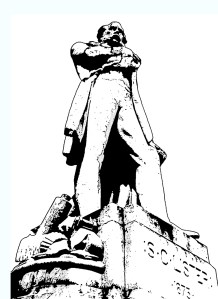(1815 – 1906)
Born in Calverley, near Bradford, Lister was a hugely successful inventor and textile industrialist.
Lister was the grandson of a wealthy textile manufacturer and landowner in Addingham and went on to play a key role in the development of Bradford’s textile industry in the nineteenth century. Starting out with help of his father in worsted spinning and manufacturing, he patented many new inventions including the Lister nip comb which revolutionised the textile industry. He went on to build and own Lister’s Mill in Manningham which was the largest silk factory in the world.
At its height, Lister’s Mill employed 11,000 men, women and children – manufacturing high-quality textiles such as velvet and silk. This venture made Lister a multi-millionaire.
In 1870 Lister sold the grounds of Manningham Hall to Bradford Corporation for less than half its value and it was made into Lister Park for the public of Bradford. He later donated money towards the creation of Cartwright Hall Art Gallery which stands in the park.
In 1891 he was made a peer and his title is taken from the Yorkshire town of Masham, close to which is Swinton Park, purchased by him in 1888. In 1898 he was made a Freeman of Bradford.
The Statue
Lister Park, Bradford 9, Grade II listed, white Sicilian marble, Sculptor- Matthew Noble
The statue of Lister which stands at the main entrance Bradford’s Lister Park depicts him standing with a two-foot rule clasped across his chest, whilst his left hand rests on a scroll of paper, presumably plans of his inventions.4 inlaid bronze plaques in the granite base show a sheep grazing, wool being combed by hand and two of his inventions – a velvet loom and a silk combing machine.
The statue was unveiled in Lister’s presence in 1875 by W. E. Forster, then Member of Parliament for Bradford.
Lister Today
Samuel Cunliffe Lister is memorialized not only by his statue, the name of the park it stands in and the name of streets across Bradford but by the magnificent Grade II* listed, Lister’s Mill with its 76-metre-high chimney called Lister’s pride which dominates the Bradford’s skyline.
No longer in production Lister’s mill was converted to luxury apartments and commercial space in 2006. Lister is primarily viewed as a great Victorian entrepreneur and captain of industry who provided employment for thousands and brought wealth to the city.
However, Lister is also remembered for the harsh treatment of his workers in 1890 when he reduced their wages by 25 percent just before Christmas leading to the Manningham mill strike, riots in Bradford town centre and the workers being forced back to work. These events were hugely significant in the trade union movement and led to the formation of the Independent Labour Party being formed in in Bradford in 1893.
It is also evident that, as with much of British industry in the 19th century, the creation of his wealth had links with colonialism and slavery. You can see this in worsted manufacturing which involved use of a cotton warp produced by slaves in the southern states of America. And in his invention of the combing machine. Its success contributed greatly to the development of Australian sheep farming and the clearance from the land and destruction of aboriginal people in this process.

